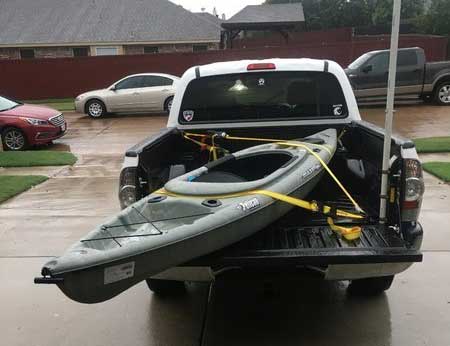When it’s a beautiful day outside, it can be the perfect time to enjoy the weather while paddling in a kayak. If that’s how you like to spend your time out in Mother Nature, you’re not alone. According to the Outdoor Foundation, nearly 23 million Americans “took to rivers, streams, lakes, and oceans” to enjoy paddling in 2018 alone—with recreational kayaking growing in popularity.
To go kayaking, though, you need to get your boat to the waterway of choice—and this process includes getting it into your truck and carefully securing it in place. Before you do this, make sure your truck bed liner is one that doesn’t allow slippage. Having a kayak bump around in back can not only damage the boat; it can also bang up your truck bed—and, if you have any other items in the truck bed, without a non-slip bed liner, this cargo can also damage the kayak and truck.
Now, here are the steps to take.
1) Make Room in the Bed
If you’re already storing cargo in the truck bed, take out what needs to be removed to make room for the boat (or, if practical, remove all of it).
2) Slide in and Position the Kayak
Lower the tailgate. Next, you’ll need to slide the boat into the bed, hull side down. You may need to use a cart to accomplish this or ask a friend to help.
Although it might seem as though you should put the kayak in the middle of the bed, it’s recommended that you position it so its stern is in a front corner and the bow in the opposite corner by the tailgate. Think diagonal. This helps to keep the kayak from sliding out and makes it easier to secure it in place.
3) Time to Tie it Down
Using cam buckle tie-down straps, use the truck bed’s anchor points and the kayak’s carry handles or scupper holes to secure it. If you haven’t yet installed anchor points on the truck—and you intend to spend time kayaking—it can make sense to add them.
Typically, two straps are needed to tie down the boat, running parallel to the tailgate and perpendicular to the kayak. They should be tight enough to secure the boat but not so tight that they could damage it. Although it might be tempting to use bungee cords, don’t. As they stretch, hooks can become undone and the boat can slide out into the road, causing problems. Close the tailgate, cushioning it, as needed.
If the kayak is overhanging the bed, attach a red colored flag or cloth to the boat’s end to make it easy for other drivers to spot it. If you have any questions about the overhang, check with traffic laws in the geographical areas where you’ll be driving to make sure you comply with them. If the kayak is longer than 11 feet, you will probably need to secure the boat on top of the cab using a rack system.
 Take your time when securing the kayak to the bed and keep your eye on it while you drive to your destination, staying at a reasonable driving speed throughout. If you hear any strange noises coming from the bed, pull over and check to see how securely the boat is attached. You may need to retighten it.
Take your time when securing the kayak to the bed and keep your eye on it while you drive to your destination, staying at a reasonable driving speed throughout. If you hear any strange noises coming from the bed, pull over and check to see how securely the boat is attached. You may need to retighten it.
Need a Truck Bed Liner?
DualLiner truck bed liners are thick, ZeroSkid® rubber bed mats, ideal for preventing the kayak from skidding. This is a complete system for Chevy, Ford, GMC, and RAM trucks, with five-piece interlocking technology providing a custom-fit, durable solution to secure cargo. Components lock together to provide complete protection without any need for drilling or expensive coatings.
To create the skid-free nature of the rubber mat, compressed radial tire rubber is combined with recycled rubber to create a more pliable material. A nylacord mixture is added, which creates a durable material with tensile strength.
Made in the USA, these truck bed liners are installed in minutes and come with a true lifetime warranty. Questions about the best truck bed liner for your needs? Contact us online or call 800-992-1949.



